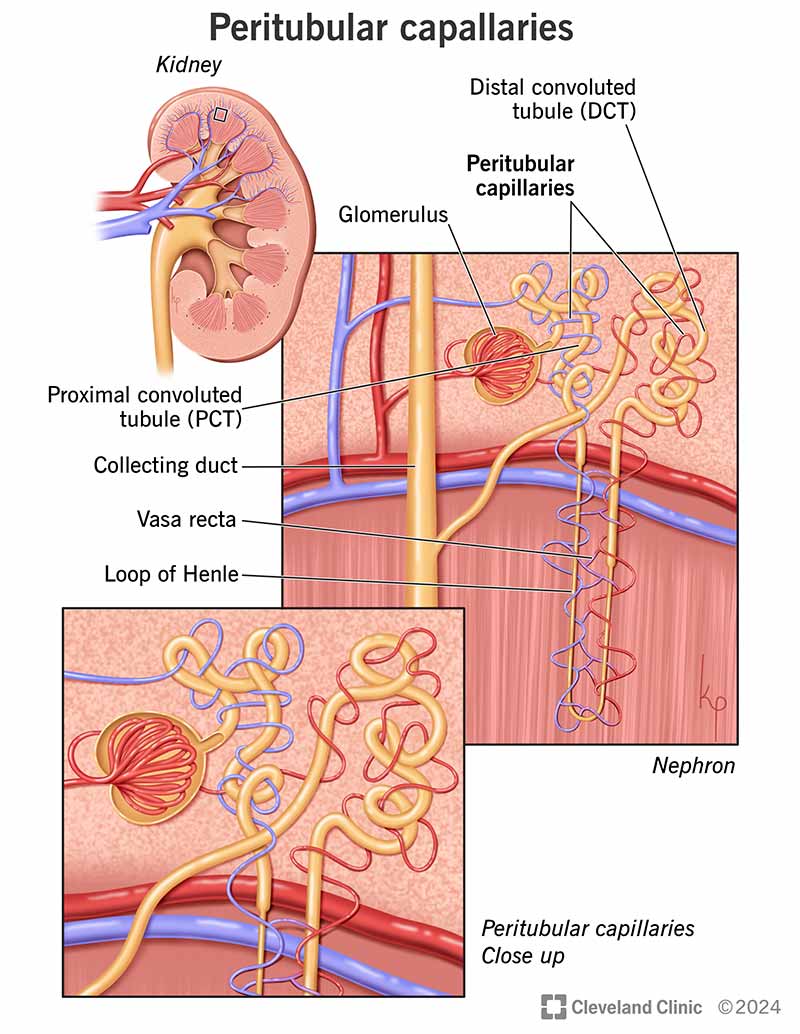Peritubular capillaries are tiny blood vessels in your kidneys. They filter wastes from your blood, which leave your body through your pee. Peritubular capillaries also reabsorb nutrients that your body needs to work properly, such as minerals. You have millions of these capillaries inside your kidneys’ filtering units.
Advertisement
Cleveland Clinic is a non-profit academic medical center. Advertising on our site helps support our mission. We do not endorse non-Cleveland Clinic products or services. Policy
Peritubular capillaries (PER-uh-TOO-byoo-ler KAP-uh-ler-eez) are tiny blood vessels in your kidneys. They play an essential role in your urinary system: They deliver wastes that you eventually get rid of when you urinate (pee). They also reabsorb nutrients that your body needs.
Advertisement
Cleveland Clinic is a non-profit academic medical center. Advertising on our site helps support our mission. We do not endorse non-Cleveland Clinic products or services. Policy
“Peritubular” means it’s around small tubes (tubules).
Peritubular capillaries help your urinary system get rid of wastes, including:
They move cell wastes and excess water through your kidney’s filtering units (nephrons). The wastes travel into your urinary bladder and leave your body through your pee.
Peritubular capillaries also reabsorb substances your body needs to work properly, including:
They supply blood and oxygen to the cells in a system of tubes in your kidneys, as well.
Your peritubular capillaries secrete waste products and excess water.

Each of your kidneys contains about 1 million nephrons. A nephron is a single kidney filtering unit. Nephrons include a filter (glomerulus, plural glomeruli), and a system of different types of tubes. The tubes reabsorb nutrients and water that the glomerulus filters out.
Peritubular capillaries are so small that you can’t see them with the naked eye. You need a microscope to see them. They’re a fenestrated blood vessel. That means each capillary has tiny openings (pores).
Advertisement
The pores make it easier for fluids and substances such as minerals and waste products to move back and forth between the capillaries and the tissues that surround them. Each pore has a thin tissue (membrane) that opens and closes, allowing larger molecules to pass through easily.
Blood enters your kidneys through your renal arteries. Your renal artery is a large blood vessel that branches into smaller blood vessels (afferent arterioles), which lead to the nephrons. The glomeruli in your nephrons filter your blood, the blood passes through different arterioles (efferent arterioles) and into your peritubular capillaries. When blood leaves your peritubular capillaries, it flows through veins that gradually get larger until it exits your body through your renal vein.
Certain health conditions and diseases, including inflammation and scarring, can damage your peritubular capillaries. This damage can lead to a loss in density in your capillaries (peritubular capillary rarefaction). Density is the amount of mass an object has compared to its volume. The loss in density affects how your capillaries work.
Damaged peritubular capillaries aren’t very good at repairing themselves. Because they can’t work as they should, peritubular capillary rarefaction contributes to chronic kidney disease (CKD) and high blood pressure (hypertension). These conditions are common. In the U.S., nearly half of all adults have high blood pressure, and about 15% of adults have some type of CKD. Without treatment, kidney disease may lead to kidney failure.
Kidney disease can result from or occur alongside several conditions, including:
You may not have any symptoms even if there’s something wrong with your peritubular capillaries. But if you do, common signs include:
A healthcare provider may recommend the following tests if they suspect there’s something wrong with your peritubular capillaries:
Kidney function tests include:
Noninvasive imaging tests may include:
You may not always be able to prevent peritubular capillary damage. But you can lower your risk of kidney problems and other health conditions by focusing on your overall health. This includes:
Advertisement
Your kidneys have a lot of little parts that work together to keep you healthy. Peritubular capillaries play an essential role in helping your urinary system filter waste from your blood. They also reabsorb useful nutrients that support your health. You have millions of peritubular capillaries in your kidneys. To keep these and other capillaries working as they should, it’s a good idea to be mindful of your overall health. Drink plenty of water, follow nutritious eating plans, see your provider for regular checkups and maintain a healthy weight for you.
Advertisement
Cleveland Clinic’s primary care providers offer lifelong medical care. From sinus infections and high blood pressure to preventive screening, we’re here for you.

Last reviewed on 10/22/2024.
Learn more about the Health Library and our editorial process.